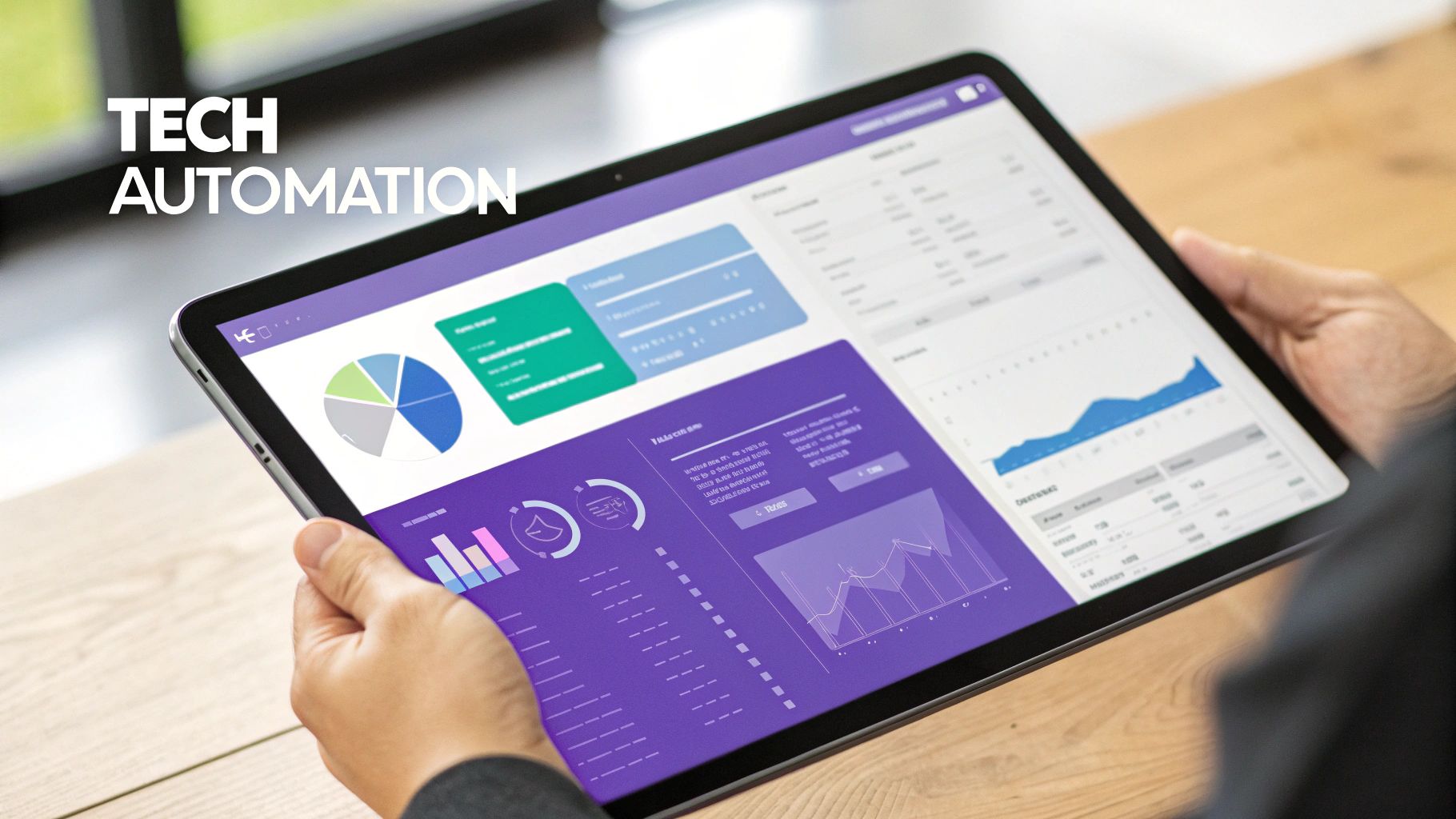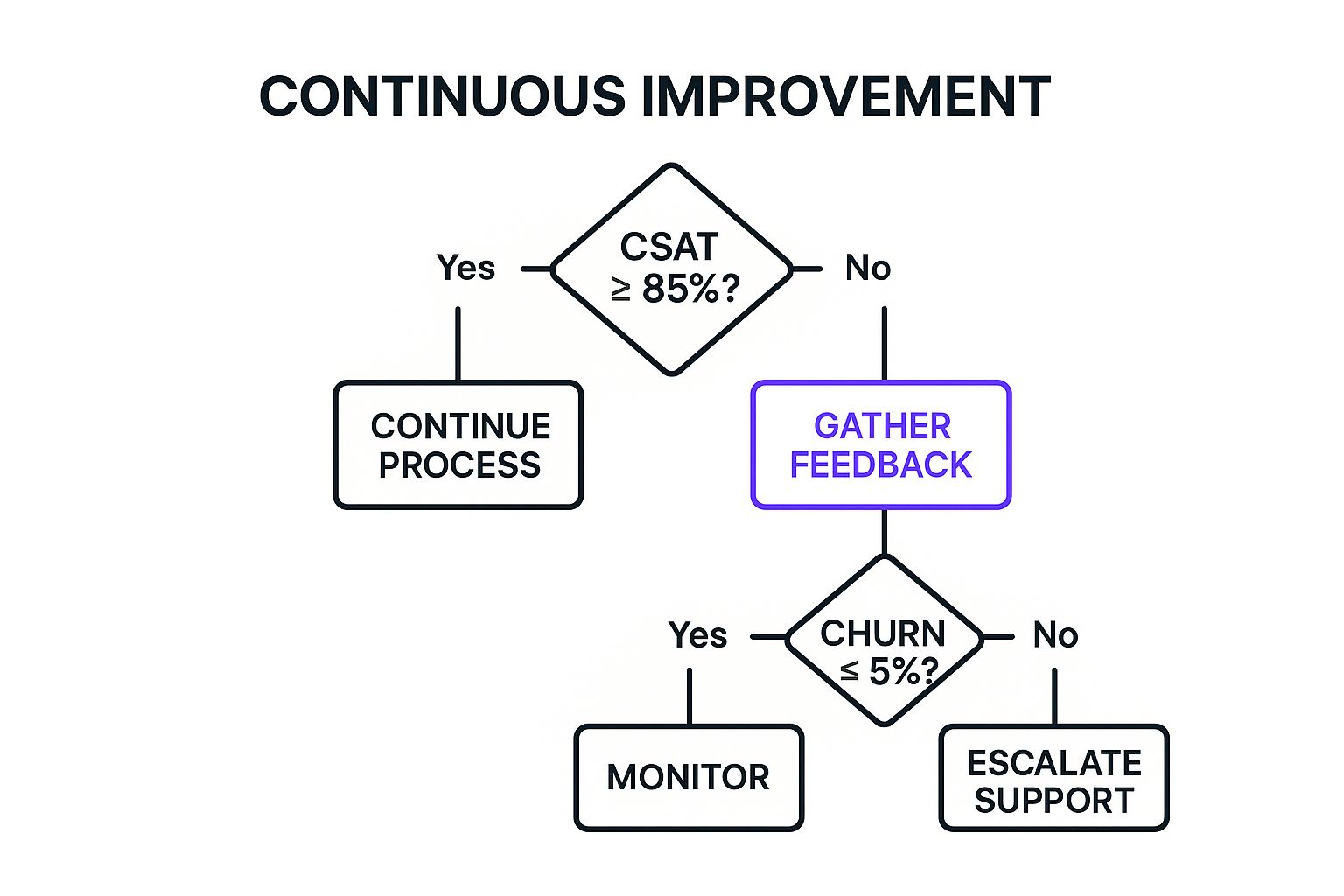
To truly scale your customer success efforts, you have to stop thinking linearly. You can't just keep hiring more Customer Success Managers (CSMs) for every new batch of customers. That’s a path to unsustainable costs. The real key is to engineer a system—a foundation built on smart segmentation, clear customer outcomes, and repeatable playbooks that deliver value consistently and efficiently.
Think of it like this: you need to build the engine before you slam your foot on the accelerator.
Before you can even dream of scaling, you need a solid blueprint. This isn't about some lofty, abstract theory; it's about putting the practical groundwork in place to support real, sustainable growth. Trying to scale on a shaky foundation—where all customers are treated the same and your team lacks clear goals—is just a recipe for chaos. You'll burn out your CSMs and, worse, you'll end up with a revolving door of unhappy customers.
The first move is to stop guessing and start defining. You have to get crystal clear on what a "successful customer" actually looks like for your business. It's not just about them logging in or using a few features. It’s about them achieving their specific business goals because of your product.
So, what does a "win" actually look like? A successful customer profile is a sharp, measurable definition that connects your customer's goals directly to your own revenue targets. Without it, your team is essentially flying blind.
By defining this profile, you create a North Star for everyone. Your team's job shifts from "keeping customers happy" to actively guiding them toward a well-defined state of success.
Let's be honest: not all customers are created equal, so they shouldn't be treated that way. One of the biggest mistakes I see teams make is segmenting customers based only on company size or how much they pay you. To scale effectively, you have to get smarter and segment by their needs, their growth potential, and the kind of journey that makes sense for them.
A tiered service model is the bedrock of scalable customer success. It ensures your most valuable resource—your team's time—is allocated to the customers who need it most and have the greatest growth potential.
A practical segmentation model might look something like this:
Once you have your segments, you can map out the ideal journey for each one. This means pinpointing the critical moments—the touchpoints—where a CSM's intervention can have the biggest impact. These moments often happen during onboarding, when a customer hits their first "aha!" moment, and around renewal time.
For each of these touchpoints, build a simple, repeatable playbook. A playbook is just a documented set of actions a CSM should take. For example, the onboarding playbook for a high-touch client might be a detailed 90-day plan with weekly check-ins. For your tech-touch segment, the "playbook" might be an automated 5-part email course triggered after sign-up.
For a comprehensive overview of how to build and grow your customer engagement efforts, explore these proven strategies for scaling customer support. This foundation of defined segments and practical playbooks is absolutely non-negotiable if you're serious about scaling customer success.

As your customer base grows, your first instinct might be to just hire more Customer Success Managers (CSMs). It seems logical, but it's a trap. Simply throwing more people at the problem is a direct path to bloated costs and operational chaos.
The real key to scaling is designing an intelligent, adaptable team structure. It’s about making sure your most valuable asset—your CSMs' time and expertise—is spent where it matters most. This means building your team around the service tiers we talked about earlier: high-touch, low-touch, and tech-touch. Each one needs a different kind of engagement, and often, a different kind of person.
Most CS teams I've seen start with a generalist model. Everybody does a little bit of everything—onboarding, support, renewals, you name it. That works for a while, but as you scale, it breaks down. Customer needs get more complex, and you need people with deep, specialized knowledge to solve them.
This is where you start to see specialized roles emerge. It's a natural and crucial evolution. By creating dedicated roles, you not only boost efficiency but also create clear career paths, which is huge for keeping your best people around.
Think about building your team with a mix of specialists:
As you build out these roles, you need a hiring process that’s just as thoughtful as your service model. Gut feelings and vague job descriptions won't cut it. You need a data-informed process that zeroes in on candidates with the right blend of skills.
A great CSM has a rare mix of soft skills and business acumen. They need genuine empathy to feel a customer's pain, but also the strategic mind to guide them toward a business solution.
The most effective CSMs don't just solve problems; they anticipate them. They are strategic advisors who can connect the dots between product features and the customer's larger business objectives.
I always recommend using scenario-based questions in interviews. For instance, ask a candidate how they’d handle a high-value account with low product usage that's up for renewal in three months. Their response will tell you far more about their strategic thinking than any question about their resume.
This shift toward strategic, revenue-focused CS isn't just a hunch; the numbers back it up. The global customer success platforms market is projected to reach $3.1 billion by 2026, showing just how much companies are investing here. While 93.7% of companies measure CS impact with metrics like Net Revenue Retention, a surprising 37% still don't have a defined strategy in place. You can dive deeper into these trends in Custify's detailed customer success statistics report.
Getting the right people in the door is just the beginning. Your product is going to change, your customers' goals will shift, and the market will evolve. Your team's skills need to keep pace. A solid new-hire onboarding plan is a must, but the learning can't stop there.
You need a culture of continuous development. Here are a few things that have worked well for teams I've managed:
A well-structured team that never stops learning is the engine that powers a truly scalable customer success program.
If you're serious about scaling customer success, you have to get out of the spreadsheet trenches. Relying on manual work and brute force simply won’t cut it as your customer base grows. The real goal is to build a smart tech stack that actually empowers your team, not bury them in more administrative busywork.
This shift from human-powered grunt work to tech-enabled workflows is absolutely essential for efficient scaling. It’s what frees up your Customer Success Managers (CSMs) from soul-crushing, low-value tasks so they can focus on what people do best: having strategic conversations, solving complex problems, and building the genuine relationships that actually drive renewals and expansion.
Think of your technology as the central nervous system for your entire customer success operation. It should be constantly gathering data and triggering the right actions at precisely the right time. The key here is to start with a solid foundation and only add complexity as you really need it.
For any scaling CS team, a robust tech stack usually boils down to a few core components:
This core stack is the backbone of your scaling efforts. It’s what lets you build repeatable, data-driven processes that work whether you have 100 customers or 10,000.
Once you have the right tools in place, you can start automating the workflows that used to eat up countless CSM hours. And let me be clear: automation isn't about removing the human touch. It’s about applying it where it matters most.
For example, you can set up proactive alerts based on product usage data. If you see that a key feature’s adoption rate drops below a certain threshold for a high-value account, an automated alert can ping the dedicated CSM. This prompts them to reach out before it becomes a churn risk.
On the other side, you can automate entire email sequences for onboarding new users in your low-touch segment. A well-designed series of emails can guide them through setup, point out key features, and link to help articles, giving them a consistent and effective experience without any direct CSM intervention.
Let technology handle the predictable so your team can manage the exceptional. By automating routine check-ins and data gathering, you give your CSMs the breathing room to handle the nuanced, high-impact conversations that a machine never could.
Picking the right Customer Success Platform is one of the most critical decisions you'll make. The market is crowded, and every platform has its own strengths. A truly powerful CSP gives you that coveted holistic view of customer health, blending different data points into a single, actionable score.
This screenshot from Gainsight, a leader in the space, gives you a peek at how it can surface key customer insights and even suggest what a CSM should do next.

You can see how a modern CSP turns a flood of raw data into a clear, prioritized to-do list, making sure your team focuses their energy on the accounts that need them most.
As you start looking at different platforms, keep these factors in mind:
The right technology is more than just another tool; it becomes a strategic partner. Looking ahead, tech's role is only going to get bigger. By 2025, personalized customer success is expected to be the norm, with companies using advanced analytics and AI to deeply understand customer needs. This will further weave CS into the core business strategy, fueling both growth and retention. You can discover more insights about these 2025 customer success trends to see how automation will continue to free up CSMs for more strategic work.

If you want to truly scale your customer success efforts, you need to make a critical mental shift. It's not about getting customers to simply use your product. It’s about ensuring they succeed because of it.
A customer logging in every day looks great on a dashboard, but it's a vanity metric if they aren't hitting the business goals that led them to you in the first place. Real, sustainable scale happens when you stop obsessing over feature adoption and start acting like an indispensable partner in your customer’s growth.
This single change elevates your CSMs from a reactive support role to that of a strategic advisor. The conversation shifts from, "Are you using this new feature?" to "How did that feature help you hit your Q3 efficiency targets?" This outcome-driven mindset is the foundation for long-term retention and expansion, cementing your product's place in their tech stack.
So, where do you start? The first practical step is to rethink what "success" even means. Product usage data has its place, but it's only one piece of the puzzle. You have to dig deeper to find the value metrics that your customers actually care about—the specific, tangible results that impact their bottom line.
This means getting in the trenches with your customers to truly understand their "why."
When you anchor your efforts to these kinds of outcomes, you're speaking their language and directly connecting your product to their business objectives.
Quarterly Business Reviews (QBRs) are the perfect stage to bring this to life. Far too many QBRs are just a one-way street where a CSM reads off a list of usage stats. It's time to flip that script. Make them collaborative, strategic sessions focused on mutual wins and, most importantly, return on investment.
The most powerful question a CSM can ask in a QBR isn't "What do you think of our product?" It's "How has our partnership helped you achieve your business goals this quarter?"
That one question changes everything. It immediately steers the conversation toward tangible value. To really nail this, your team needs to understand and demonstrate the financial impact of your partnership. A solid grasp of customer experience ROI provides the framework to prove your team's value in concrete, dollars-and-cents terms.
When it's time to talk renewal, there should be no surprises. If you've spent the entire year laser-focused on delivering business outcomes, the renewal conversation is just a formality—a simple summary of the value you've already proven. The discussion naturally moves from "Should we renew?" to "How can we achieve even more together next year?"
This isn't just theory; it's where the entire field is headed. By 2025, experts predict customer success will have fully pivoted from adoption-based metrics to true outcome-based partnerships. Teams will own growth targets by aligning with customers on shared, measurable goals, not just by supporting product features.
This strategic pivot, often powered by AI and automation, builds deeper trust and makes your customer relationships stickier. It's how you build a customer success engine that scales right alongside your business.
You can't fly blind when scaling customer success. Relying on gut feelings about what’s working is a surefire way to burn through resources and watch your churn rate climb. To build a CS engine that truly lasts and adapts with your business, you need to be guided by data.
This means looking past the usual suspects like Net Promoter Score (NPS). While NPS offers a quick pulse check on customer sentiment, it barely scratches the surface. To really understand the health of your scaled program, you have to connect your team's day-to-day work with tangible business outcomes.
As you grow, your metrics need to grow up, too. It's time to shift focus from activity metrics—like the number of calls made or emails sent—to the KPIs that tell a story about real business impact. These are the numbers that get your leadership team and board to sit up and listen because they speak directly to revenue and the long-term health of the company.
A few of the most critical ones include:
A well-designed Customer Health Score is your crystal ball. It turns reactive firefighting into proactive problem-solving, allowing your team to intervene precisely when and where they can have the most impact.
When you orient your team around these outcome-driven metrics, you can finally draw a straight line from your CS program to the company's bottom line, making it much easier to justify future investments in your team and tools.
Data is pretty useless if it's just gathering dust in a spreadsheet. The real magic happens when you bring it to life in dynamic dashboards that give everyone—from front-line CSMs to the C-suite—the at-a-glance insights they need.
For instance, a CSM's dashboard should be all about their portfolio, immediately highlighting accounts with dipping health scores or upcoming renewals. A leadership dashboard, on the other hand, needs to show the bigger picture: aggregate trends in NRR, churn rates broken down by customer segment, and the all-important CSM-to-customer ratio.
To keep everything straight, here’s a quick look at the core metrics you should be tracking and why they're so important as you scale.
This table breaks down the key metrics to track, what they measure, and why they are critical for evaluating the performance and impact of your scaled CS initiatives.
Tracking these KPIs provides a clear, objective view of your program's health, allowing you to make smarter decisions about where to invest your time and resources.
Measuring performance is only half the job. You have to actually use that data to get better. This is all about creating a tight feedback loop where the insights from your KPIs directly shape your team's actions.
For example, if you see that customers who complete a certain onboarding milestone have a 20% higher retention rate, you need to double down on getting every new user through that step. Or if a specific customer segment consistently has low health scores, it might be a signal to rethink your service model for that group or develop more targeted resources.
This cycle of measuring, analyzing, and refining is what ensures your CS engine doesn't just get bigger—it gets smarter. In the end, your program’s value is proven by its impact on core business goals, especially churn. For a deeper dive, I recommend exploring effective strategies for reducing churn rate and boosting retention. This commitment to data-driven improvement is what separates a truly scalable program from one that just adds headcount.
As you start to grow your customer success function, you're bound to run into some tough, practical questions. Moving from a reactive, fire-fighting mode to a strategic, scalable model brings its own set of challenges. Let's tackle some of the most common questions I hear from leaders making this transition.
Before you even think about new software or hiring sprees, your absolute first step is to define and segment your customer base. You have to get crystal clear on who your customers are and what they genuinely need from you to succeed with your product.
Start by creating logical segments. This could be based on size (Enterprise vs. SMB), industry, or even the specific problems they're trying to solve with your product. Once you have these groups, map out the ideal customer journey for each one. This foundational work is what allows you to build out tiered service levels—think a high-touch, white-glove approach for your strategic accounts, and a low-touch or fully tech-touch model for smaller ones.
If you skip this step, you’ll end up throwing your most expensive resource—your people—at accounts that could have been served perfectly well with automation. That’s a surefire way to kill your efficiency and make scaling impossible.
Think of AI as a force multiplier for your team. It gives them superpowers by handling the heavy lifting of prediction and automation, freeing them up for what humans do best.
First and foremost, AI is brilliant at sifting through massive amounts of data—product usage stats, support ticket history, survey feedback, you name it. It analyzes all of this to create a predictive Customer Health Score. This score can flag an at-risk account long before a busy CSM might spot the warning signs on their own.
AI also takes over the repetitive, manual tasks that bog CSMs down. It can automate onboarding email sequences, help schedule quarterly business reviews, or power a chatbot to give customers instant answers to common questions. This gives your CSMs their time back, allowing them to focus on high-value, strategic work like running business reviews and sniffing out expansion opportunities. The end result? Each CSM can manage a larger book of business far more effectively.
The real power of AI isn't replacement; it's augmentation. It handles the monotonous tasks, empowering CSMs to operate at a more strategic level and build stronger human relationships where they count the most.
This graphic shows a simple decision tree that illustrates how data can trigger different actions to continuously improve your processes.

The key takeaway here is that negative signals, like a low CSAT score or a dip in usage, should automatically kick off a specific, predefined workflow. This ensures nothing important ever falls through the cracks.
From my experience, one of the biggest missteps is simply throwing more people at the problem. Leaders hire more CSMs without first fixing their underlying processes or implementing the right technology. This leads to what we call linear scaling, where your costs balloon right alongside your customer count. It’s a hamster wheel, not a sustainable growth engine.
Another frequent error is getting stuck in a reactive posture. If your team spends all its time putting out fires, they'll never have the headspace to build the proactive, automated playbooks that prevent those fires in the first place. The goal isn't just to get better at solving problems; it's to stop them from happening at all.
Finally, a lot of teams fail to evolve their metrics. They cling to old-school, activity-based KPIs (like the number of calls made) instead of shifting to outcome-based metrics that prove financial impact. A truly scaled CS organization can confidently point to its direct contribution to business-critical results like Net Revenue Retention and customer lifetime value.
By steering clear of these common pitfalls and leaning into a strategic, data-driven framework, you can build a customer success function that doesn't just grow—it scales intelligently.
Ready to transform your customer data into actionable insights? With Statisfy, you can automate workflows and empower your CSMs to focus on what matters most—building strong customer relationships. Discover how our AI-driven platform can drive proactive interventions and improve your renewal rates. Learn more about what Statisfy can do for you.